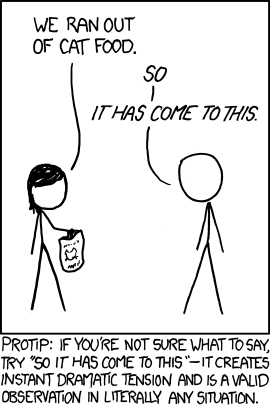I like where this is going, and am looking forward to future installments.
However, you did trigger my OCD:
I'm also not sure if an AI would use the probability of both parties surviving as the optimization goal, as opposed to the expected number of survivors (0.9+0.2 = 1.1 for scenario 1, 0.6+0.6 = 1.2 for scenario 2).
Neither target is really satisfactory, though. For example:
Scenario 3: {driver 1: 100%}, {driver 2: 0%}
Scenario 4: {driver 1: 90%}, {driver 2: 10%}
If we maximize the probability of both surviving as the goal, then we would pick scenario 4 (.09) over scenario 3 (0.0). If we maximize the expected number of survivors, we wouldn't know which to pick (the answer is 1.0 for both).
However, scenario 3 is arguably better, because one person is guaranteed to live, while in scenario 4, there is a 0.09 chance of both dying.
I'm gonna think about this for a bit.
Quote from: Doktor Howl on August 18, 2018, 09:57:21 PMTurning the radio on is a nice touch. The reason for it is obvious in hindsight, but the incongruity made my brain hit a speedbump.
I fire the explosive pins in the car's frame, trigger the air bags, and turn the radio on.
However, you did trigger my OCD:
Quote0.6*0.6 = 0.36, 0.9*0.2 = 0.18. Did you have the other driver with a 30% chance of survival in an earlier draft? Am I making a mistake in assuming that the appearance of statistical independence in scenario 2 implies the same in scenario 1? Or am I just another asshole obsessed with irrelevant minutiae?
The first scenario leaves Daniel with a 90% chance of surviving, but leaves the other driver with only a 20% chance of survival, for best-case outcome odds of .27. The second scenario gives both drivers a 60% chance of survival, with best-case outcome odds of .36.
I'm also not sure if an AI would use the probability of both parties surviving as the optimization goal, as opposed to the expected number of survivors (0.9+0.2 = 1.1 for scenario 1, 0.6+0.6 = 1.2 for scenario 2).
Neither target is really satisfactory, though. For example:
Scenario 3: {driver 1: 100%}, {driver 2: 0%}
Scenario 4: {driver 1: 90%}, {driver 2: 10%}
If we maximize the probability of both surviving as the goal, then we would pick scenario 4 (.09) over scenario 3 (0.0). If we maximize the expected number of survivors, we wouldn't know which to pick (the answer is 1.0 for both).
However, scenario 3 is arguably better, because one person is guaranteed to live, while in scenario 4, there is a 0.09 chance of both dying.
I'm gonna think about this for a bit.


